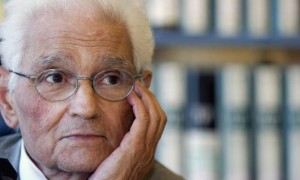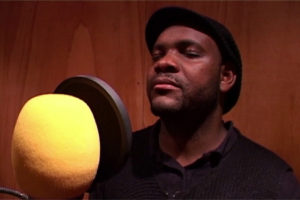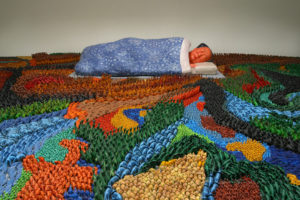The Supplement at the Origin: Or, Deconstruction in a Nutshell
These reflections were included in Apropos of Nothing: Deconstruction, Psychoanalysis, and the Coen Brothers (SUNY, U.P.). They can be cited here as: Buckner, Clark. “The Supplement at the Origin: Or, Deconstruction in a Nutshell.” www.clarkbuckner.com. Web. Day, Month, Year article as accessed.
Jacques Derrida emerged on the French intellectual scene in the early 1960’s, at a time when Europe still reeled from the horror and devastation of the Second World War, while also facing anti-colonial struggles abroad – including specifically, in Vietnam and Algeria – and undergoing tumultuous social changes at home. While both the victory over fascism and these emancipatory struggles depended upon the liberal principles of rational self-determination, the crises they presented also implicated, and so, called into question, the value of modern, scientific self-consciousness, and the Enlightenment project as a whole. Rather than merely an aberrant departure from the rationality of modern life, the rise of fascism appeared to be symptomatic of it, the deviant excess of its own self-transparent objectivity, and, in different ways, all parties were implicated in the atrocities of the war. The principles and practices of modern science contributed directly to the exploitations of colonialism, and served to justify and sustain domestic social hierarchies. As anticipated already by many leading critical theorists of the late 19th and earlier 20th Centuries, Derrida’s philosophy thus registers and works to redress the crisis of legitimation, engendered by this dialectic of Enlightement, revealing the inconsistencies and exclusions integral to the project of remaking the world in the light of reason, and elaborating new strategies to orient and sustain critical reflection.
In popular discourse, Derrida’s critical methodology, “deconstruction,” has come to be used frequently, and somewhat revealingly, to mean simply “critical analysis.” Strictly speaking, however, to deconstruct is to subvert the logic of a system by revealing its organizing principles to presuppose the phenomena that they purportedly justify and explain. What Derrida calls, finding “the supplement at the origin” (Derrida, 1976; 313). Contrary to the conventions of formal logic, however, Derrida does not merely dismiss his objects of study, as fallacious. Instead, he reveals how their seeming coherence is predicated upon a differential underdetermination, which both disturbs and makes possible their proper functioning. When deconstructing a philosophical system, literary text, or social organization, Derrida thus indeed suspends the authority of its governing principles – but from within, on the basis of their own immanent contradictions, and without thereby simply leaving them behind. Instead, through his interventions, he discloses possibilities intrinsic to the phenomena they organize, by showing them to have been always already otherwise; and, through his broader philosophical project, he works to cultivate a general attunement to experience, which is open to the singularity of phenomena in the alterity.
As paradigmatic of such a deconstructive reversal, Derrida famously argues that, “writing precedes speech” (Derrida, 1976; X). In the essay, “Signature, Event, Context,” he formulates this postulate in response to the 18th-Century French philosopher, Étienne Condillac, whose work he holds up as paradigmatic of representational theories of language. According to Condillac, writing serves as a practical means to extend the field of speech, in the absence of the person with whom one wants to converse. Implicitly, Condillac thus conceives linguistic exchange as predicated upon a homogeneous, ideal medium, which subtends communication, in all of its variations, and ultimately is grounded in the self-presence of the conscious subject. Derrida writes, “Thought as representation, precedes and governs communication, which transports the ‘idea’ the signified content.” It is possible because, “men are already in a state that allows them to communicate their thoughts to themselves” (Derrida, 1978; 4). In Condillac’s philosophy, writing thus serves to supplement speech, which itself supplements thought, as the representation of a representation; and the absence that distinguishes writing is conceived as a derivative form of presence: both descriptively, insofar as it extends the context of the spoken exchange, and normatively, as lesser form of it, on account of its apparently greater propensity for misunderstanding.
Against Condillac’s concept of writing as a supplementary extension of the subject’s self-presence, however, Derrida argues that the absence that informs its use must be conceived rather as radical. In order for a ‘written communication’ to retain its function as writing, he contends, “it must be repeatable – iterable – in the absolute absence of any empirically determinable collectivity of receivers;” and he argues that this categorical absence applies equally to the author. Writing must be readable, even if the author “no longer answers for what he has written,” whether “because of a temporary absence, because he is dead” or, more generally, because he has not invested it” fully with “the desire to say what he means. The author’s relationship to his own writing is thus closer to that of the reader than commonly understood; and the written mark is qualified by an “essential drift,” which qualifies its integrity, as a paradoxical condition of its functioning properly (Derrida, 1978; 9). Derrida writes,
By virtue of its essential iterablity, a written syntagma can always be detached from the chain in which it is inserted or given without causing it to lose all possibility of functioning, if not all possibility of ‘communicating,’ precisely. One can perhaps come to recognize other possibilities in it by inscribing it or grafting it onto other chains (Derrida, 1978; 9).
As Derrida conceives it, this iterability entails both difference and repetition, as a potential for substitution that conditions the written mark in its originality and so divides it from itself, in the very constitution of its identity. Writing effectively has been “always already” grafted into and from another context, as a (logically) prior condition of its original use, and so means something more and different than one intends, as a condition of meaning anything at all.
Radicalizing these claims, and reinforcing the implications that he draws from them, Derrida then argues that the same categorical absence conditions the possibility of speech. In order for the spoken word to signify, he contends, it too must be recognizable and repeatable beyond the limits of its immediately expressed intention. Rather than rooted in experience, or the understanding of the self-conscious subject, speech registers a division from the world and the subject’s ideas, which enables its characteristic abstraction from experience, and exchange between different people. Derrida conceives this division as fundamental: as an interability that precedes and conditions its possible use, rendering the spoken word too inherently inconsistent, and qualifying its significance similarly as always already otherwise. In fact, he conceives speech as a form of writing – what he calls, “a grapheme in general,” defining it specifically as “the nonpresent remainder of a differential mark cut off from its putative ‘production’ or origin” (Derrida, 1988a; 10). Whereas Condillac implicitly presupposes a homogeneous ideal presence, which subtends communication in its various forms, Derrida thus discerns the absence, conventionally attributed to writing, already at work in the apparent immediacy of speech; and he extends this negativity finally to the self-presence of the subject, which provides the ultimate source and guarantee of meaning, in Condillac’s representational hierarchy.
Derrida’s strategic reversal of speech and writing, in “Signature Even Context,” closely approximates the distinction, drawn by seminal Swiss linguist Ferdinand de Saussure, between speech (la parole) and language (la langue). Working in the late 19th-Century, Saussure contributed to the development of his field, first and foremost, by conceiving it as the scientific study of signs, a semiotics, rather than the philological study of language’s historical development. Distilling the sign into its component parts – as signifier (the linguistic mark), signified (its meaning), and referent (the object on which it is brought to bear) – Saussure argued that the words we use have no natural relationship to the things they present. Instead, their meaning results from their relationship to other words, within the broader context of a signifying chain. “In language,” he famously asserted, “there are only differences without positive terms” (Saussure, 1966; 120). The distinction that Saussure draws between speech and language follows from this fundamental understanding. Rather than grounded in the self-understanding of the intentional subject, Saussure argued that the meaning of the subject’s speech depends upon the differential system of language, which conditions its possibility. As integral to his broader de-substantialization of linguistic meaning, Saussure’s semiotics thus displaces the self-conscious subject, central to the humanist tradition; and, indeed, his theory contributes directly to the development of the modern social sciences, most notably, through the work of anthropologist Claude Levi-Strauss.
In the early formulation of his philosophy, Derrida draws heavily upon the accomplishments of structuralism, and he celebrates it, in the essay, “Structure, Sign, and Play in the Discourse of the Human Sciences,” as a “rupture” in the history of Western thought. While the concept of structure is as old as the tradition itself, Derrida contends that it thus far has been conceived as giving order to experience, as a system of relations, organized around a fundamental orienting principle. While decisive to the structure’s organization, this orienting principle occupied a distinct position in it, as ultimately independent from the internal dynamics of the structure itself. As both integral to the structure, and yet beyond the qualification of its internal dynamics, Derrida formalizes the role of this orienting principle, as, what he calls, the “transcendental signified.” Drawing upon Martin Heidegger’s critique of the philosophical reduction of Being, as a dynamic process of coming to be and passing away, to the stasis of an immediately given being, Derrida explains the history of Western thought and culture, as a history of the structure, defined by the shifting concepts of this transcendental signified. He writes,
The entire history of the concept of structure, before the rupture of which we are speaking, must be thought of as a series of substitutions of center for center, as a linked chain of determinations of the center. Successively, and in a regulated fashion, the center receives different forms of names. The history of metaphysics, like the history of the West, is the history of these metaphors and metonymies. Its matrix… is the determination of Being as presence (Derrida, 1978; 279).
Further clarifying the scope and orienting concerns of his philosophical project, Derrida expounds these paradigmatic names, “eidos, arche, telos, enegeia, ousia (essence, existence, substance, subject) aletheia, consciousness, God, man, and so forth” (Derrida, 1978; 279 – 280).
According to Derrida, structuralism’s break from this history of the structure lies, not only its renunciation of such transcendental signifieds, but also, in its critical interrogation of the limiting conditions of their institution, or, what he calls, “the structurality of the structure” (Derrida, 1978; 280) And he takes it to be paradigmatic of, what has come to be known as, the “linguistic turn,” in Twentieth-Century philosophy. For Derrida, however, this appeal to language means something both more specific and more general than commonly understood. He writes, “This was the moment, when language invaded the universal problematic, the moment when, in the absence of a center or origin, everything became discourse – provided we can agree on this world – that is to say a system in which the central signified, the original, or transcendental signified, is never absolutely present outside a system of difference” (Derrida, 1978; 280). By raising the question of “the structurality of the structure,” and addressing its concerns in terms of the differential dynamics of “discourse,” Derrida argues that structuralism “de-centers” the Western philosophical tradition, conceiving its first principles as inherently contradictory, surrogate place holders, which substitute for something that never, in fact, existed. Rather than a “present-being” with a fixed, “natural site” the center thus comes to be understood rather as a “function, a sort of nonlocus in which an infinite number of sign-substitutions came into play” (Derrida, 1978; 280).
When celebrating the structuralist break from “the history of the structure,” Derrida thus explains it in terms that are consistent with his own assertion of the primacy of writing before speech. Indeed, the argument put forth in “Signature Event Play” essentially brings the structuralist critique of the humanist tradition to bear specifically on Condillac’s representational theory of language. However, Derrida also criticizes structuralism, not for being insufficiently radical in its critique of metaphysics – as one might suppose, in light of his skepticism – but rather, paradoxically, for being too radical in its claim to scientific novelty. With specific regard to Levi-Strauss’ The Raw and the Cooked, Derrida argues that, insofar as he proposes to surmount the classical philosophical opposition between the sensible and the intelligible, by undertaking his analysis exclusively in terms of structuralism’s scientifically rigorous concept of the sign, he effaces the very conditions of the concept to which he appeals, and so remains implicitly inscribed within the tradition he purports to leave behind. The concept of the sign, Derrida writes, “has been determined by this opposition throughout the totality of its history,” and it bears the associations of this inheritance, even if put forth on radically new grounds. In fact, he argues that precisely at the point where Levi-Strauss supposes to have shed this history, it ultimately over-determines his analysis. Generalizing the point, Derrida writes, “If one erases the radical difference between signifier and signified, it is the word ‘signifier’ itself which must be abandoned as a metaphysical concept” (Derrida, 1978; 281).
When arguing that, “writing precedes speech,” Derrida does not therefore simply add rhetorical flourish to an otherwise essentially structuralist argument. Instead, he redoubles the critical negativity of the structuralist “rupture,” by both criticizing the “transcendental signifieds” of the philosophical tradition in light of the differential negativity of discourse, and refusing the simple subversion of established hierarchies as always already informed by the conventions that they would leave behind. If purportedly self-present phenomena are indeed qualified by a differential underdetermination, Derrida contends that it is equally impossible to conceive difference altogether independently from its reification in a fixed presence, and he argues that these two contrary dynamics cannot be resolved to a third, independent principle, but rather exhibit an “irreducible mutual inclusion,” whose aporetic undecidability he takes to be a quasi-transcendental condition of experience. In the closing passages of “Signature Event Context,” Derrida accordingly reflects on his persistent usage of, what he calls, “the old name,” writing, by explaining deconstruction as, “a double gesture, a double science, a double writing,” which effects both “a reversal of the classical opposition and a general displacement of the system” (Derrida, 1988a; 21). While working to reveal the absence integral to identity, Derrida thus simultaneously problematizes this strategy, by showing the differential underdetermination of identity to be qualified by the self-presence it subverts. In this regard, deconstruction entails a surprisingly conservative tendency, which refuses any simple opposition to the status quo. However, Derrida conceives this apparently conservative concession as, in fact, necessary to spurning further critique. And by problematizing not only the object of his study, but also the terms of its critique, Derrida holds open the possibility of the altogether different.




